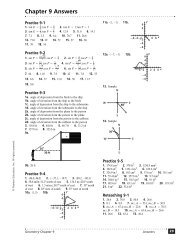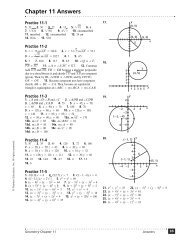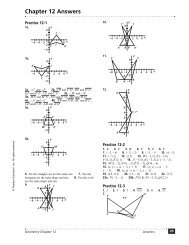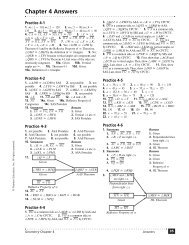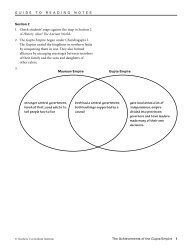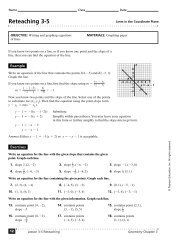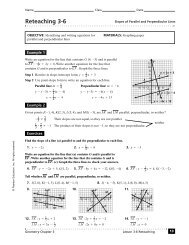Chapter 12 Sequences; Induction; the Binomial Theorem
Chapter 12 Sequences; Induction; the Binomial Theorem
Chapter 12 Sequences; Induction; the Binomial Theorem
You also want an ePaper? Increase the reach of your titles
YUMPU automatically turns print PDFs into web optimized ePapers that Google loves.
<strong>Chapter</strong> <strong>12</strong> Test<br />
2. a1 an<br />
an<br />
− 1<br />
= 4; = 3 + 2<br />
a2 = 3a1+ 2= 3( 4)<br />
+ 2=<br />
14<br />
a3 = 3a2<br />
+ 2= 3( 14)<br />
+ 2=<br />
44<br />
a4 = 3a3<br />
+ 2= 3( 44)<br />
+ 2=<br />
134<br />
a = 3a<br />
+ 2 = 3 134 + 2 = 404<br />
5 4<br />
( )<br />
The first five terms of <strong>the</strong> sequence are 4, 14, 44,<br />
134, and 404.<br />
3<br />
3. ∑ ( 1)<br />
4.<br />
5.<br />
k = 1<br />
k + 1 ⎛k<br />
+ 1⎞<br />
− ⎜ 2 ⎟<br />
⎝ k ⎠<br />
11 + 1+ 1 21 + 2+ 1 31 + 3+<br />
1<br />
= ( − 1<br />
⎛ ⎞<br />
) ( 1<br />
⎛ ⎞<br />
) ( 1<br />
⎛ ⎞<br />
⎜ )<br />
2<br />
⎟+ − ⎜<br />
2<br />
⎟+ − ⎜ 2 ⎟<br />
⎝ 1 ⎠ ⎝ 2 ⎠ ⎝ 3 ⎠<br />
2⎛2⎞ 3⎛3⎞ 4⎛4⎞<br />
= ( − 1) ⎜ ( 1) ( 1)<br />
1<br />
⎟+ − ⎜<br />
4<br />
⎟+ − ⎜<br />
9<br />
⎟<br />
⎝ ⎠ ⎝ ⎠ ⎝ ⎠<br />
3 4 61<br />
= 2 − + = 4 9 36<br />
4<br />
∑<br />
k<br />
⎡⎛2<br />
⎞ ⎤<br />
⎢⎜<br />
− k ⎥<br />
3<br />
⎟<br />
⎢⎣⎝<br />
⎠ ⎥⎦<br />
k = 1<br />
⎡ 1 ⎤ ⎡ 2 ⎤ ⎡ 3 ⎤ ⎡ 4<br />
⎤<br />
2 2 2 2<br />
( ) ( ) ( ) ( )<br />
= ⎢ − 1 2 3 4<br />
3 ⎥ + ⎢ −<br />
3 ⎥ + ⎢ −<br />
3 ⎥ + ⎢ −<br />
3 ⎥<br />
⎣ ⎦ ⎣ ⎦ ⎣ ⎦ ⎣ ⎦<br />
⎛2 ⎞ ⎛4 ⎞ ⎛ 8 ⎞ ⎛16<br />
⎞<br />
= ⎜ − 1 2 3 4<br />
3<br />
⎟+ ⎜ −<br />
9<br />
⎟+ ⎜ −<br />
27<br />
⎟+ ⎜ −<br />
81<br />
⎟<br />
⎝ ⎠ ⎝ ⎠ ⎝ ⎠ ⎝ ⎠<br />
1 14 73 308<br />
=− − − −<br />
3 9 27 81<br />
680<br />
=−<br />
81<br />
2 3 4 11<br />
− + − + ... +<br />
5 6 7 14<br />
Notice that <strong>the</strong> signs of each term alternate, with<br />
<strong>the</strong> first term being negative. This implies that<br />
<strong>the</strong> general term will include a power of − 1 .<br />
Also note that <strong>the</strong> numerator is always 1 more<br />
than <strong>the</strong> term number and <strong>the</strong> denominator is 4<br />
more than <strong>the</strong> term number. Thus, each term is in<br />
k ⎛ k + 1 ⎞<br />
<strong>the</strong> form ( −1)<br />
⎜<br />
k + 4<br />
⎟. The last numerator is 11<br />
⎝ ⎠<br />
which indicates that <strong>the</strong>re are 10 terms.<br />
10<br />
2 3 4 11 k ⎛ k + 1⎞<br />
− + − + ... + = ( 1)<br />
5 6 7 14<br />
∑ − ⎜<br />
k + 4<br />
⎟<br />
⎝ ⎠<br />
k = 1<br />
6. 6,<strong>12</strong>,36,144,...<br />
<strong>12</strong> − 6 = 6 and 36 − <strong>12</strong> = 24<br />
The difference between consecutive terms is not<br />
constant. Therefore, <strong>the</strong> sequence is not<br />
arithmetic.<br />
7.<br />
<strong>12</strong> = 2 and 36<br />
6 <strong>12</strong><br />
= 3<br />
The ratio of consecutive terms is not constant.<br />
Therefore, <strong>the</strong> sequence is not geometric.<br />
1 4<br />
n<br />
a n = − ⋅<br />
2<br />
1 n 1 n−1<br />
a − ⋅4 − ⋅4 ⋅4<br />
n 2 2<br />
= = = 4<br />
a 1 n−1 1 n−1<br />
− ⋅4 − ⋅4<br />
n−1 2 2<br />
Since <strong>the</strong> ratio of consecutive terms is constant,<br />
<strong>the</strong> sequence is geometric with common ratio<br />
1 1<br />
r = 4 and first term a 1 =− ⋅ 4 =− 2 .<br />
2<br />
The sum of <strong>the</strong> first n terms of <strong>the</strong> sequence is<br />
given by<br />
n<br />
1−<br />
r<br />
Sn<br />
= a1<br />
⋅<br />
1−<br />
r<br />
n<br />
1−<br />
4<br />
=−2⋅<br />
1 − 4<br />
2<br />
( 1 4<br />
n<br />
= − )<br />
3<br />
8. −2, −10, −18, − 26,...<br />
−10 −( − 2)<br />
= − 8 , ( )<br />
−18 − − 10 = − 8 ,<br />
−26 −( − 18)<br />
= − 8<br />
The difference between consecutive terms is<br />
constant. Therefore, <strong>the</strong> sequence is arithmetic<br />
with common difference d =− 8 and first term<br />
a 1 = − 2 .<br />
an<br />
= a1 + ( n−1)<br />
d<br />
= − 2+ ( n −1)( −8)<br />
=−2− 8n<br />
+ 8<br />
= 6−8n<br />
The sum of <strong>the</strong> first n terms of <strong>the</strong> sequence is<br />
given by<br />
n<br />
Sn<br />
= ( a+<br />
an)<br />
2<br />
n<br />
= ( − 2+ 6−8n)<br />
2<br />
n<br />
= ( 4−8n)<br />
2<br />
= n 2−4n<br />
( )<br />
<strong>12</strong>81<br />
© 2009 Pearson Education, Inc., Upper Saddle River, NJ. All rights reserved. This material is protected under all copyright laws as <strong>the</strong>y currently<br />
exist. No portion of this material may be reproduced, in any form or by any means, without permission in writing from <strong>the</strong> publisher.




